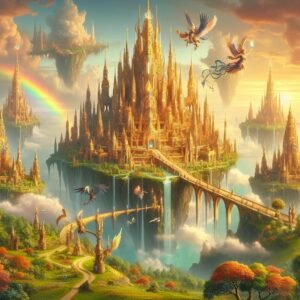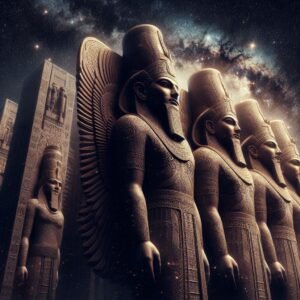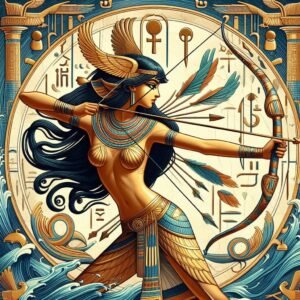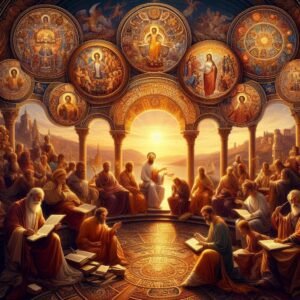
Nergal, also known as Erra, was a prominent deity in Mesopotamian mythology, revered as the god of war, death, and disease. He was associated with the underworld and often depicted as a fierce and destructive force. Nergal’s primary cult centre was the city of Kutha, where he was worshipped as the ruler of the underworld.
Nergal and Ereshkigal
One of the most well-known myths involving Nergal is his descent to the underworld, where he becomes the consort of Ereshkigal, the queen of the underworld. This union grants him kingship over the underworld. Nergal was also linked to pestilence and plague, embodying the destructive aspects of nature. Despite his fearsome attributes, he was sometimes seen as a benefactor who could hear prayers and offer protection.
Nergal’s descent to the underworld is a captivating tale in Mesopotamian mythology. The story begins with Nergal offending Namtar (sukkal), the vizier of Ereshkigal, the queen of the underworld, during a divine banquet. As punishment, Nergal is sent to the underworld to apologize. Upon his arrival, Ereshkigal is captivated by Nergal, and they spend six days together, during which they fall in love.
However, Nergal initially abandons Ereshkigal and returns to the heavens. Ereshkigal, heartbroken, demands his return. Eventually, Nergal descends again, this time to stay, and they become co-rulers of the underworld. This myth highlights themes of love, power, and the complex relationships between gods in Mesopotamian mythology.
Nergal’s descent to the underworld and his marriage to Ereshkigal significantly elevated his status within the Mesopotamian pantheon. By becoming the co-ruler of the underworld, Nergal gained dominion over death and the afterlife, which expanded his influence beyond his original domains of war and disease. This transformation allowed him to embody both destructive and protective aspects, making him a more complex and multifaceted deity.
King of the underworld
His role as the king of the underworld also positioned him as a crucial figure in the balance between life and death, reinforcing his importance in Mesopotamian cosmology. This duality made Nergal a powerful and feared god, invoked for both protection and punishment.
After Nergal’s descent to the underworld and his marriage to Ereshkigal, other gods interacted with him differently, recognizing his elevated status as the co-ruler of the underworld. This new role granted him greater authority and respect among the deities. For instance, gods who previously saw him primarily as a war and plague deity now acknowledged his dominion over the dead and his influence in the afterlife.
Nergal’s enhanced position also meant that he became a key figure in divine decisions related to the underworld and the fate of souls. His interactions with other gods often involved matters of life and death, reflecting his dual nature as both a destructive and protective force. This shift in dynamics underscored his importance in maintaining the balance between the earthly and divine realms.
Changes to Nergal’s worship
After Nergal’s descent to the underworld and his marriage to Ereshkigal, his worship underwent significant changes. His role as the co-ruler of the underworld elevated his status, making him a more prominent deity in the Mesopotamian pantheon. Worship of Nergal expanded beyond his original associations with war and plague to include his dominion over death and the afterlife.
His primary cult centre remained in Kutha, but his influence spread to other cities like Dilbat, Isin, Uruk, and Nippur. Nergal’s worshippers began to invoke him not only for protection in battle and against disease, but also for guidance and protection in matters related to death and the afterlife. This broadened his appeal and solidified his importance in both the earthly and divine realms.
Rituals and festivals
Rituals and festivals dedicated to Nergal often involved offerings and ceremonies to appease him and seek his protection. Worshippers would present animals, weapons, food, and jewels at his temples, particularly at his main cult centre in Kutha. These offerings were meant to avoid his wrath and gain his favour, especially given his associations with war, disease, and death.
The Epic of Erra
One notable ritual involved reciting the Epic of Erra, a story about Nergal’s destructive rage, to protect against evil and misfortune. This epic was used in ceremonies to invoke Nergal’s power for protection and to ward off calamities. These practices highlight the dual nature of Nergal as both a fearsome and protective deity in Mesopotamian mythology.
The Epic of Erra is a significant Babylonian literary work from the first millennium BCE. It tells the story of Erra, the god of mayhem and pestilence, who unleashes chaos and destruction upon the world. The epic is rich in imagery and dialogue, depicting the horrors of war and societal unrest. Erra is eventually pacified, and peace is restored to Babylonia. The text also explores themes of divine wrath and human suffering, making it a profound reflection on the fragility of civilization.
The Epic of Erra features several key events that drive its narrative. It begins with Erra, the god of mayhem, being roused from his slumber by his advisor Išum and the Seven, who are destructive deities. Erra unleashes chaos across Babylonia, leading to widespread destruction and suffering. Even Marduk, the patron god of Babylon, temporarily relinquishes his throne to Erra. The epic includes intense battles in cities like Babylon, Sippar, and Uruk, where both the righteous and unrighteous are indiscriminately killed. Eventually, Erra’s fury is pacified, and he withdraws, allowing peace to return to the land.
Devastating Battles
The battles in the Epic of Erra are intense and devastating, reflecting the chaos unleashed by Erra and his destructive companions, the Seven. Erra’s rampage leads to fierce conflicts in major cities like Babylon, Sippar, Uruk, Dūr-Kurigalzu, and Dēr. These battles are marked by indiscriminate slaughter, where both the righteous and the unrighteous fall victim to the violence. The epic vividly describes the horrors of war, with shrines, temples, palaces, and homes being destroyed, and families turning against each other. Eventually, Erra’s fury is quelled, and peace is restored to the land.
In the Epic of Erra, the Seven, also known as the Sibitti or Sebetti, play a crucial role as Erra’s companions and instruments of destruction. Created by the god Anu, they are described as “peerless warriors” and are personified weapons of chaos. These seven minor war gods accompany Erra into battle, amplifying the devastation he brings upon cities like Babylon, Sippar, and Uruk. Their presence intensifies the chaos, leading to indiscriminate slaughter and widespread destruction. The Seven’s warlike nature and their role as Erra’s enforcers highlight the epic’s themes of divine wrath and the fragility of human civilization.
The Seven, also known as the Sibitti or Sebetti, are described as “peerless warriors” in the “Epic of Erra.” Their names are not explicitly listed in the epic itself, but they are often associated with various warlike and destructive attributes. In other Mesopotamian texts, the Seven are sometimes identified with the Pleiades or other stellar phenomena. They are depicted as powerful and fearsome entities, created by the god Anu to serve as Erra’s instruments of chaos.
Subscribe to our post updates - Don't miss a thing!!








